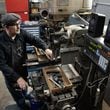Dance Preview
"James Brown: Get on the Good Foot — A Celebration in Dance"
8 p.m. Saturday, Nov. 9. $39.72-$65.64. Rialto Center for the Arts. 80 Forsyth Street NW. 404-413-9849. rialto.gsu.edu
It started on the “One!” James Brown would say. That was where his explosive song and electrifying dance moves met with the muscular, driving rhythm of funk. Born of traditional gospel and soul music, Brown’s innovative sound continues to influence R&B, jazz, rock, hip-hop and rap today. And his dazzling dance steps, delivered in coiffed hair and glittering cape, raised the world’s expectations for what constituted a good stage show.
Celebrating the Godfather of Soul’s twin talents in a dance production seemed like a good idea just waiting to happen. Enter director/choreographer Otis Sallid, who co-conceived “Smokey Joe’s Cafe,” one of the longest-running musical revues on Broadway. Voila! You have “James Brown: Get on the Good Foot — A Celebration in Dance,” a national touring show that plays the Rialto Center for the Arts Nov. 9.
The late playwright August Wilson once told Sallid, who lives in Decatur, that his work must possess an ancestral spirit, or it wouldn’t last. Since then, Sallid has created several celebrations of American popular music, ranging from 19th-century Negro spirituals to a tribute to Henry Mancini’s West Coast jazz. Earlier this year, he produced, directed and choreographed “Harlem’s Big Otis Jump Up Blues Revue” in New York, featuring music by Big Joe Turner, Duke Ellington, La Vern Baker, among others. Sallid views the kind of music he trades in as our country’s classical music; he sees James Brown as a classical musician and an ancestor. “And not just for black people,” he said. “James spoke to everybody. Everybody got funky.”
In fact, his goal for “Get on the Good Foot” is to bring the funk audience to dance, and dance audience to funk.
During a recent rehearsal break at CORE Dance Studios in Decatur, Sallid said the idea for the show began when he woke up one morning and wondered, “What happened to James Brown?
“He died and no one said anything,” Sallid recalled. “It was important to me that someone as influential as James Brown not be so disposable.”
Brown, who grew up in Augusta, liked to watch how his audience danced when he toured. He folded their moves into his act and took them on the road, where others picked them up. Michael Jackson later studied Brown’s quick steps, knee drops and corkscrew spins. Brown’s gliding moves [ultimately] gave rise to the King of Pop’s signature moonwalk. Those moves continue to inspire generations of hip-hoppers.
Sallid conceived of a show in which choreographers from around the world would illustrate how Brown’s music and dance had influenced contemporary culture.
He took his idea to Mikki Shepard, executive producer at the Apollo Theater, where Brown had a long history. His debut there in 1959 was a big career break; he went on to record three significant albums there and performed on the stage more 200 times.
Shepard recruited Philadanco, a company respected for its diverse repertory and dynamic contemporary dancers, and formed residency partnerships with the Rialto Center and the City of Lafayette, Louisiana. Sallid chose 33 of Brown’s songs, lined up choreographers and let each one choose from the list and develop an artistic vision. The result is a variety of perspectives with diverse takes on Brown’s music, style and message.
For “Say It Loud, I’m Black and I’m Proud,” New York-based choreographer Abdel Salaam gave his piece a political spin, blending African and modern dance.
Set to Brown's "Please, Please, Please" and "Get Up (I Feel Like Being a) Sex Machine," choreographer Souleymane Badolo's "Benon" references Brown's early life — boxing and shining shoes — and shows how Brown "flew above" the difficulties of his youth.
Emerging choreographer Camille A. Brown created “1973,” a comic piece based on the 1970s blaxploitation film genre set to “I Got You (I Feel Good).” Ronald K. Brown, a Brooklyn-based choreographer with international reach, has combined aspects of West African and Cuban dance in his piece titled “Think,” with the songs, “Think (About It),” “I Got the Feelin’” and “Get on the Good Foot.”
What doesn’t make an appearance in the show is Brown’s late-career struggles with drug addiction and incarceration. Shepard explained that the production is not a biography, but a celebration. Choreographers chose to focus on “who Brown was as an artist, and his innovation,” she said.
Sallid hopes people will come away with a greater respect for Brown and will see him as a national treasure. For the choreographers, he said, the greatest inspiration was Brown’s message: “to have the courage to be yourself, to laugh at yourself, and to have a good time.”
Shepard hopes to take “Get on the Good Foot” on an international tour next year. But meanwhile, Sallid will continue creating shows that celebrate great artists of American popular music.
“They all need to be talked about,” he said. “Stevie Wonder should be next.”
About the Author





